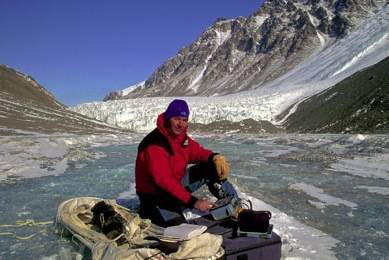Scientists Pursue Astrobiology at Carl Sagan Center

What is the Carl Sagan Center? Astrobiology has become one of the hottest fields of science, and one of the most interesting to the general public. Research in astrobiology has spread widely, with many major universities and other research institutions establishing active programs. Scientists at the SETI Institute have been doing astrobiology research for more that two decades.
The SETI Institute was founded in 1984 to provide scientific staff for the newly established SETI programs within NASA, with low administrative costs. The fact is that much of the scientific and other work of NASA is not done by government employees, but by people provided by contractors, often local universities or high-tech, for-profit industries. The magic of the SETI Institute is that it has developed good methods to achieve a low overhead rate, allowing scientists and educators to do far more with the funds granted to them.
In the Carl Sagan Center, scientists are free to spend all of their time on research; there is no requirement to serve students through teaching or mentoring, or to support institutional missions such assisting visiting scientists. That said, many volunteer to mentor undergraduate and graduate students. On the business front, the SETI Institute maintains a cadre of experts in the preparation, submission, and implementation of research proposals that assist our scientists in obtaining funding support from federal agencies and private foundations and donors.
Young scientists from all over the U.S. come to us, and their number is increasing. Frankly, our growth in the Carl Sagan Center was organic, a consequence of creating a good environment for scientific research. We didn't conduct recruiting campaigns. Word of mouth and a great track record did the recruiting for us. Finally, the group of scientists working in astrobiology became so large that we realized we had, almost unwittingly, given birth to an ensemble of leading astrobiologists that had become one of the largest in the world!
Interviews with a large cross-section of the PIs indicated that many were concerned about their institutional identity in the scientific world. For most PIs, the SETI Institute was almost exclusively known (for good reason) as the home of the Search for Extraterrestrial Intelligence (SETI) via radio and optical searches. The lack of a separate identity for other types of astrobiology research was often cited a factor that complicated fundraising. Thus, the Carl Sagan Center for the Study of Life in the Universe was created and provided an identity that is instantly recognizable and distinct from our Center for SETI Research. It provides a strategic framework for developing funding from alternative sources — including private philanthropy, and makes a clear institute commitment to supporting the full range of astrobiology.
Today, the Carl Sagan Center is home to more than 60 research projects and almost 90 scientists. To learn more about the Carl Sagan Center, please visit our website.
- Video Player: Listening for Life
- Video Player: Reflections on Fermi's Paradox
- SETI at SPACE.com
Breaking space news, the latest updates on rocket launches, skywatching events and more!
